Small overlap front
The small overlap front evaluation consists of a driver-side and a passenger-side component. If the results of the two evaluations differ, then the combined small overlap rating is equal to the lower rating.
Driver-side
- Rating applies to 2020-25 models
Tested vehicle: 2017 Chrysler Pacifica Touring
The Chrysler Pacifica was introduced in the 2017 model year as a replacement for the Chrysler Town and Country minivan. The Chrysler Voyager, available new only to fleet buyers, was introduced in the 2020 model year and shares the same platform as the Pacifica.
Two tests of the Pacifica were conducted because the driver door was torn off its hinges in the first test. As a result, Fiat Chrysler strengthened the upper hinge and reinforced the joint between the door hinge pillar and inner body panel in front of the pillar. In the second test, the upper hinge held and the door stayed shut.
The small overlap frontal ratings listed below apply only to vehicles built after August 2016, that is after the door hinge improvements were made. (Information about when a specific vehicle was manufactured is on the certification label typically affixed to the car on the driver door or adjacent B-pillar.)
| Evaluation criteria | Rating |
|---|---|
| Overall driver-side evaluation | |
| Structure and safety cage | |
| Driver injury measures | |
| Head/neck | |
| Chest | |
| Hip/thigh | |
| Lower leg/foot | |
| Driver restraints and dummy kinematics | |
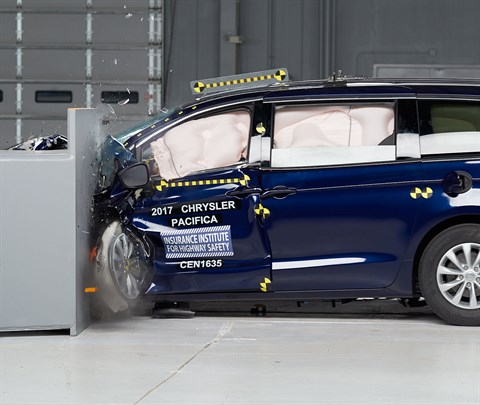
Action shot taken during the driver-side small overlap frontal crash test of the 2017 Chrysler Pacifica built after August 2016.
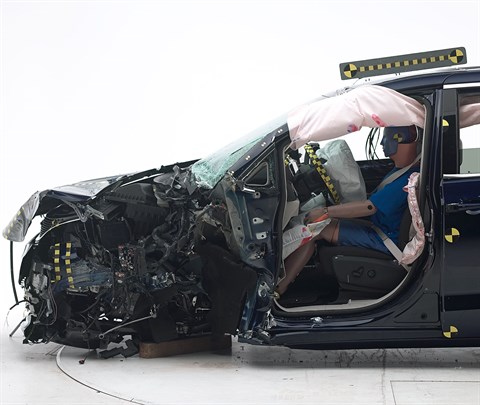
The dummy's position in relation to the door frame, steering wheel, and instrument panel after the crash test indicates that the driver's survival space was maintained reasonably well.
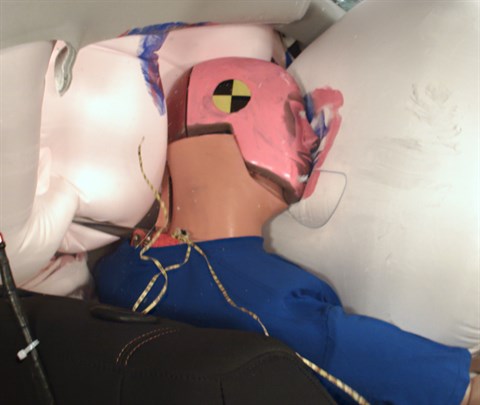
The frontal and side curtain airbags worked well together to keep the head from coming close to any stiff structure or outside objects that could cause injury.
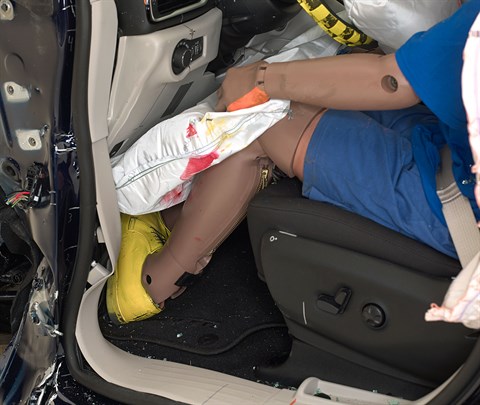
The driver's space was maintained reasonably well, and risk of injuries to the dummy's legs and feet was low.
Passenger-side
- Rating applies to 2020-25 models built after August 2020
Tested vehicle: 2020 Chrysler Pacifica Touring Plus 4-door
The Chrysler Pacifica was introduced in the 2017 model year as a replacement for the Chrysler Town and Country minivan. The Chrysler Voyager, available new only to fleet buyers, was introduced in the 2020 model year and shares the same platform as the Pacifica.
Beginning with 2020 models built after August 2020, the passenger front door hinge pillar, A-pillar and door sill was strengthened to improve occupant protection in passenger-side small overlap frontal crashes. (Information about when a specific vehicle was manufactured is on the certification label typically affixed to the car on the driver door or adjacent B-pillar.)
Passenger-side small overlap frontal ratings are assigned by the Institute based on a test of a 2020 Chrysler Pacificia conducted by Fiat Chrysler.
| Evaluation criteria | Rating |
|---|---|
| Overall passenger-side evaluation | |
| Structure and safety cage | |
| Passenger injury measures | |
| Head/neck | |
| Chest | |
| Hip/thigh | |
| Lower leg/foot | |
| Passenger restraints and dummy kinematics | |
| Driver injury measures | |
| Head/neck | |
| Chest | |
| Hip/thigh | |
| Lower leg/foot | |
| Driver restraints and dummy kinematics | |
Moderate overlap front: original test
Rating applies to 2020-25 models
Tested vehicle: 2017 Chrysler Pacifica Touring
The Chrysler Pacifica was introduced in the 2017 model year as a replacement for the Chrysler Town and Country minivan. The Chrysler Voyager, available new only to fleet buyers, was introduced in the 2020 model year and shares the same platform as the Pacifica. Moderate overlap frontal ratings are assigned by the Institute based on a test conducted by Fiat Chrysler.
| Evaluation criteria | Rating |
|---|---|
| Overall evaluation | |
| Structure and safety cage | |
| Driver injury measures | |
| Head/neck | |
| Chest | |
| Leg/foot, left | |
| Leg/foot, right | |
| Driver restraints and dummy kinematics | |
Side: original test
Rating applies to 2020-25 models
Tested vehicle: 2017 Chrysler Pacifica Touring
The Chrysler Pacifica was introduced in the 2017 model year as a replacement for the Chrysler Town and Country minivan. The Chrysler Voyager, available new only to fleet buyers, was introduced in the 2020 model year and shares the same platform as the Pacifica. Side ratings are assigned by the Institute based on a test conducted by Fiat Chrysler.
| Evaluation criteria | Rating |
|---|---|
| Overall evaluation | |
| Structure and safety cage | |
| Driver injury measures | |
| Head/neck | |
| Torso | |
| Pelvis/leg | |
| Driver head protection | |
| Rear passenger injury measures | |
| Head/neck | |
| Torso | |
| Pelvis/leg | |
| Rear passenger head protection | |
Side: updated test
Rating applies to 2023-25 models
Tested vehicle: 2023 Chrysler Pacifica Touring L 4-door
The Chrysler Pacifica was introduced in the 2017 model year as a replacement for the Chrysler Town and Country minivan. The Chrysler Voyager, available new only to fleet buyers, was introduced in the 2020 model year and shares the same platform as the Pacifica. Beginning with 2023 models, a side energy absorber was added to the front door. Additionally, beginning with 2023 models built after August, a revised latch for the rear sliding doors was implemented to improve occupant safety in side impact crashes. (Information about when a specific vehicle was manufactured is on the certification label typically affixed to the car on the driver door or adjacent B-pillar.)
| Evaluation criteria | Rating |
|---|---|
| Overall evaluation | |
| Structure and safety cage | |
| Driver injury measures | |
| Head/neck | |
| Torso | |
| Pelvis | |
| Driver head protection | |
| Rear passenger injury measures | |
| Head/neck | |
| Torso | |
| Pelvis | |
| Rear passenger head protection | |

View of the vehicle just after the crash test.

View of the vehicle after the crash with doors removed, showing the side airbags and damage to the occupant compartment.
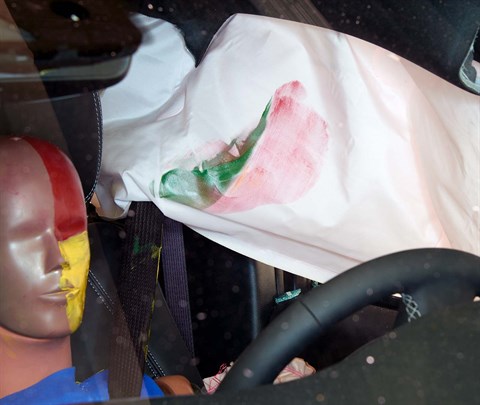
Smeared greasepaint shows where the driver dummy's head was protected from being hit by hard structures by the side airbags.
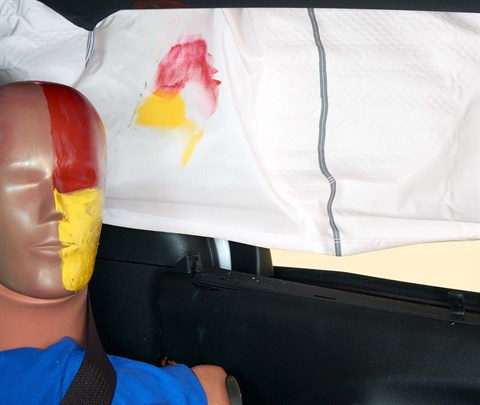
Smeared greasepaint shows where the rear passenger dummy’s head was protected by the side airbag.
Headlights
Trim level(s)
- All trims
| Evaluation criteria | Rating |
|---|---|
| Low-beam headlight type | Halogen reflector |
| High-beam headlight type | Halogen reflector |
| Curve-adaptive? | No |
| High-beam assist? | No |
|
Overall rating | |
| Distance at which headlights provide at least 5 lux illumination: | |
Low beams
On the straightaway, visibility was inadequate on both sides of the road. On curves, visibility was inadequate in all 4 tests.
The low beams never exceeded glare limits.
High beams
On the straightaway, visibility was inadequate on both sides of the road. On curves, visibility was inadequate in all 4 tests.
Front crash prevention: pedestrian (day)
Child seat anchors
Rating applies to 2021-25 models
| Evaluation criteria | Rating |
|---|---|
| Overall evaluation | |
| Vehicle trim | Touring L |
| Seat type | leather |
This vehicle has 3 rear seating positions with complete child seat attachment (LATCH) hardware.
It has 1 additional seating position with a tether anchor, a single lower anchor and the ability to borrow the second anchor from another position.
Note: When anchors are borrowed, they aren't available to use in their designated positions.
| Evaluation criteria | Rating |
|---|---|
| Overall evaluation | |
| Vehicle trim | Touring L |
| Seat type | leather |
| Rating icon | Rating |
|---|---|
| G | Good |
| A | Acceptable |
| M | Marginal |
| P | Poor |
| Seating positions that rely on borrowed lower anchors or have only a tether anchor available are not rated. | |
thether anchor symbol | Tether anchor |
lower anchor symbol | Lower anchors |
| Lower anchor(s) can be borrowed from adjacent positions(s) | |
| No hardware available |
Details by seating position
| Position | Rating |
|---|---|
| 1 | |
| Tether anchor | |
| hard-to-find location | |
| no other hardware could be confused for anchor | |
| Lower anchors | |
| not too deep in seat | |
| not too much force needed to attach | |
| easy to maneuver around anchors | |
| 3 | |
| Tether anchor | |
| hard-to-find location | |
| no other hardware could be confused for anchor | |
| Lower anchors | |
| not too deep in seat | |
| not too much force needed to attach | |
| easy to maneuver around anchors | |
| 4 | |
| Tether anchor | |
| hard-to-find location | |
| other hardware could be confused for anchor | |
| Lower anchors | |
| not too deep in seat | |
| not too much force needed to attach | |
| easy to maneuver around anchors | |
| 5 | |
| Lower anchors | |
| not too deep in seat | |
| not too much force needed to attach | |
| easy to maneuver around anchors | |
| 6 | |
| Tether anchor | |
| hard-to-find location | |
| other hardware could be confused for anchor | |
| Lower anchors | |
| 1 dedicated anchor and 1 that can be borrowed from seat 5 | |
| not too deep in seat | |
| not too much force needed to attach | |
| easy to maneuver around anchors |
